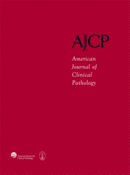-
PDF
- Split View
-
Views
-
Cite
Cite
Minoo Ghannadan, Friedrich Wimazal, Ingrid Simonitsch, Wolfgang R. Sperr, Matthias Mayerhofer, Christian Sillaber, Alexander W. Hauswirth, Helmut Gadner, Andreas Chott, Hans-Peter Horny, Klaus Lechner, Peter Valent, Immunohistochemical Detection of VEGF in the Bone Marrow of Patients With Acute Myeloid Leukemia: Correlation Between VEGF Expression and the FAB Category, American Journal of Clinical Pathology, Volume 119, Issue 5, May 2003, Pages 663–671, https://doi.org/10.1309/331QX7AXKWFJFKXM
Close - Share Icon Share
Abstract
We studied vascular endothelial growth factor (VEGF) expression in bone marrow sections obtained from 3 healthy donors and 41 patients with acute myeloid leukemia (AML) of various French-American-British (FAB) subtypes by immunohistochemical analysis using an anti-VEGF antibody. In normal bone marrow, the anti-VEGF antibody reacted with myeloid progenitor cells and megakaryocytes but not with erythroid cells or mature granulocytic cells. High levels of VEGF were found in the bone marrow in patients with AML-M1, -M2, -M3, -M4, -M4Eo, and -M5. In these leukemias, the vast majority of myeloblasts (>90%) expressed VEGF. By contrast, in AML-M0, the percentage of VEGF-positive blasts was lower in most cases (median, 42%), and if at all detectable, these blast cells contained only trace amounts of VEGF. In AML-M3 and -M4Eo, maturing granulocytes failed to express VEGF similar to granulocytes in normal bone marrow. In AML-M6, myeloblasts exhibited VEGF, whereas erythroid cells did not. In AML-M7, blast cells and megakaryocytes were identified as major sources of VEGF. In summary, VEGF expression in the bone marrow is restricted to certain stages of differentiation and maturation of myeloid cells and correlates with the FAB category.
Author notes
Supported by Fonds zur Förderung der Wissenschaftlichen Forschung, Vienna, Austria.




